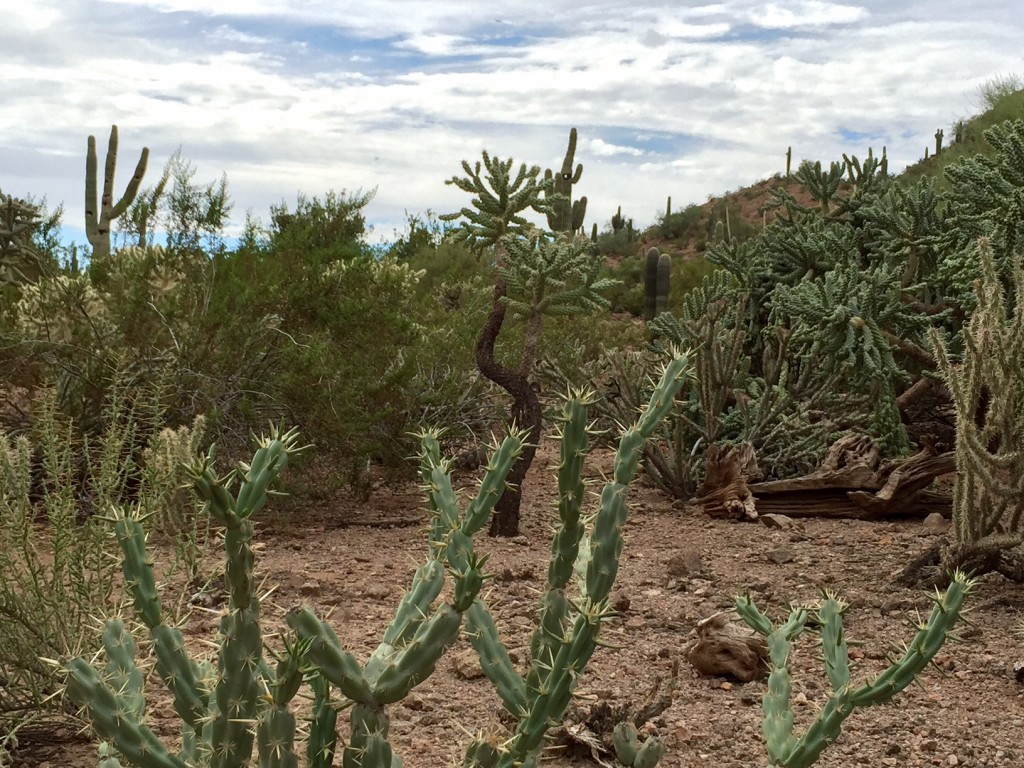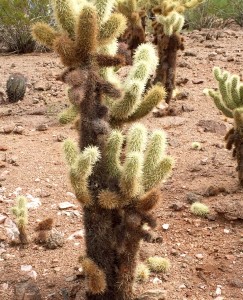Grazing in the Deserts of Mexico
Posted in Horticulture on December 8 2014, by Christian Primeau
Christian Primeau is the NYBG‘s Manager of the Enid A. Haupt Conservatory.

Winter is suddenly upon us and, as the temperatures plummet and the city braces for the inevitable snow and ice, many will find their way to the garden’s iconic Enid A. Haupt Conservatory to decompress, take a leisurely stroll among the lush, tropical foliage, and escape the bitter cold. Some, perhaps inspired by the lowland rain forest houses or the desert displays, will jet off to warmer climes. While I freely admit that I already work in paradise, it’s nice to get out and see some of my plants in habitat now and again.
I recently took an exploratory trip through the Sonoran desert of Mexico and into Arizona. By design I made no specific plans and, like a slightly less profane version of Anthony Bourdain, I had “No Reservations.” From the dusty desert proper through the dense Chaparral shrubland and semi-arid grasslands of Arizona, much of the area ranges in temperature from broiling hot to bone-chilling, depending on month and time of day. Here it was late October and still scorching with nary a cloud in the sky to provide respite.
The landscape is truly as beautiful as it is unforgiving, and the same may be said of the plant life. My arms and legs looked as if they’d been shredded by a tidal wave of furious cats; such were the hazards of botanizing in a region so thick with spiny inhabitants. I would later discover the name for a cowboy’s protective “chaps” was actually derived from the word “Chaparral”—an arid and prickly biome on the Sonoran desert’s northern border. One quickly discovers the Chaparral functions quite efficiently as human sandpaper.
With no place in particular to be, I had ample opportunity to chat with folks and, as I’m apt to do, guide conversation toward my two favorite subjects: food and plants. Lo and behold, the stars aligned and the topic of plants arose during a conversation with the chef at a grand but fraying old Mexican hotel. A man who delighted in preparing dishes from local and traditional plant food sources, I was fascinated to hear him discuss the bounty of the desert. The land had sustained indigenous peoples for many thousands of years because they simply learned when and where to search. Over a small glass of tequila (though it might have been jet fuel) and a plate of tamales we discussed the trove of nutritious botanical treasures guarded by the spiny sentries of the desert.
Of the myriad plant families that call the Sonoran home, cacti are certainly among the most recognizable and just might be, as my new friend deftly demonstrated, the most delicious when prepared properly. The abundant and vigorous prickly pear cactus (Opuntia sp.) dominates a good portion of the landscape. When stripped of its spines, seasoned, grilled, or fried and served on a fresh corn tortilla, it is the equal of any double cheeseburger, I promise you. The egg-shaped fruit of Opuntia ranges in color from red/pink to peach/orange and tastes a bit like a cross between kiwi and watermelon, making for a refreshing treat high in vitamins B and C. I personally believe it is only eclipsed in flavor by the fruit of the largest cactus in the United States, the majestic Saguaro (Carnegiea gigantea), which is complex and reminiscent of sweet fig.
As I spent the sweltering days poking through the rocky desert in search of plants, one denizen consistently and viciously poked back. With a name like teddy bear cholla (Cylindropuntia bigelovii), who wouldn’t love it? Let me tell you, this viciously armed cactus offers two things in abundance—pain in the form of copious barbed spines and plump flower buds that make a tender and surprisingly delicious low calorie side dish high in calcium and iron.

Early desert inhabitants also discovered a great many seeds with which to supplement their diet. Chia seed, made famous by the wildly popular “Chia Pets” of the 1980s, is much more than a novelty. These crunchy seeds, harvested from the blue-flowered Chia sage (Salvia hispanica), are loaded with fiber, protein, and antioxidants, and contain more Omega-3 fatty acids than salmon.
Chia seed takes full advantage of any available desert moisture and one seed can absorb up to 12 times its weight in water. For this reason, Chia is often consumed for weight-loss purposes as it swells and provides the sensation of fullness. The seed of several Pinus species are also found in abundance in higher-elevation areas. “Pine nuts” are an excellent source of protein, healthy fats, vitamins A, D, C, and E and are irresistible when toasted.
While the aromatic wood of the Mesquite tree (Prosopis sp.) is often used as a flavoring for barbecue, this member of the legume family bears bean-like pods high in protein, soluble fiber, and vitamins and has officially been dubbed a “superfood.” One of the culinary highlights of my trip was a decadent chocolate cake prepared by my friend using mesquite flour. This I dutifully inhaled while he proudly pointed out that it was not sweetened with sugar, but the condensed juice of the blue agave (Agave tequilana).
Known as “Agave Azul” south of the border, blue agave is a plant with which many have a love-hate relationship. I have countless times impaled part of my body on the sharp terminal spine at the tip of a rigid agave leaf. This pain pales in comparison, however, to the sheer havoc the fermented and distilled juice of this plant (which we all know as tequila) can cause if one isn’t careful. Recalling the memory of splitting headaches past, I thanked my new companion for his generous hospitality, declined the offer of another glass, and shuffled outside into the blazing sun to take my chances with the heat and cacti.
If you can’t find the time to travel someplace warm this winter, the Enid A. Haupt Conservatory is a tropical vacation under glass—right in your own backyard. Come and enjoy the incredible beauty it has to offer. As you explore, remember that every plant has value, a history, and a unique story. While I can’t promise that story will end with tequila and chocolate cake, I can guarantee you’ll always learn something and be captivated by what you see.
For a taste of Mexico right here in our own backyard, join us from May 16 through November 1 for FRIDA KAHLO: Art, Garden, Life, an exploration of Kahlo’s connection to her local Mexican flora and the artist’s first solo New York City exhibition in over 25 years.


The beautiful photos and witty and comprehensive text will brighten even the dreariest New York day!